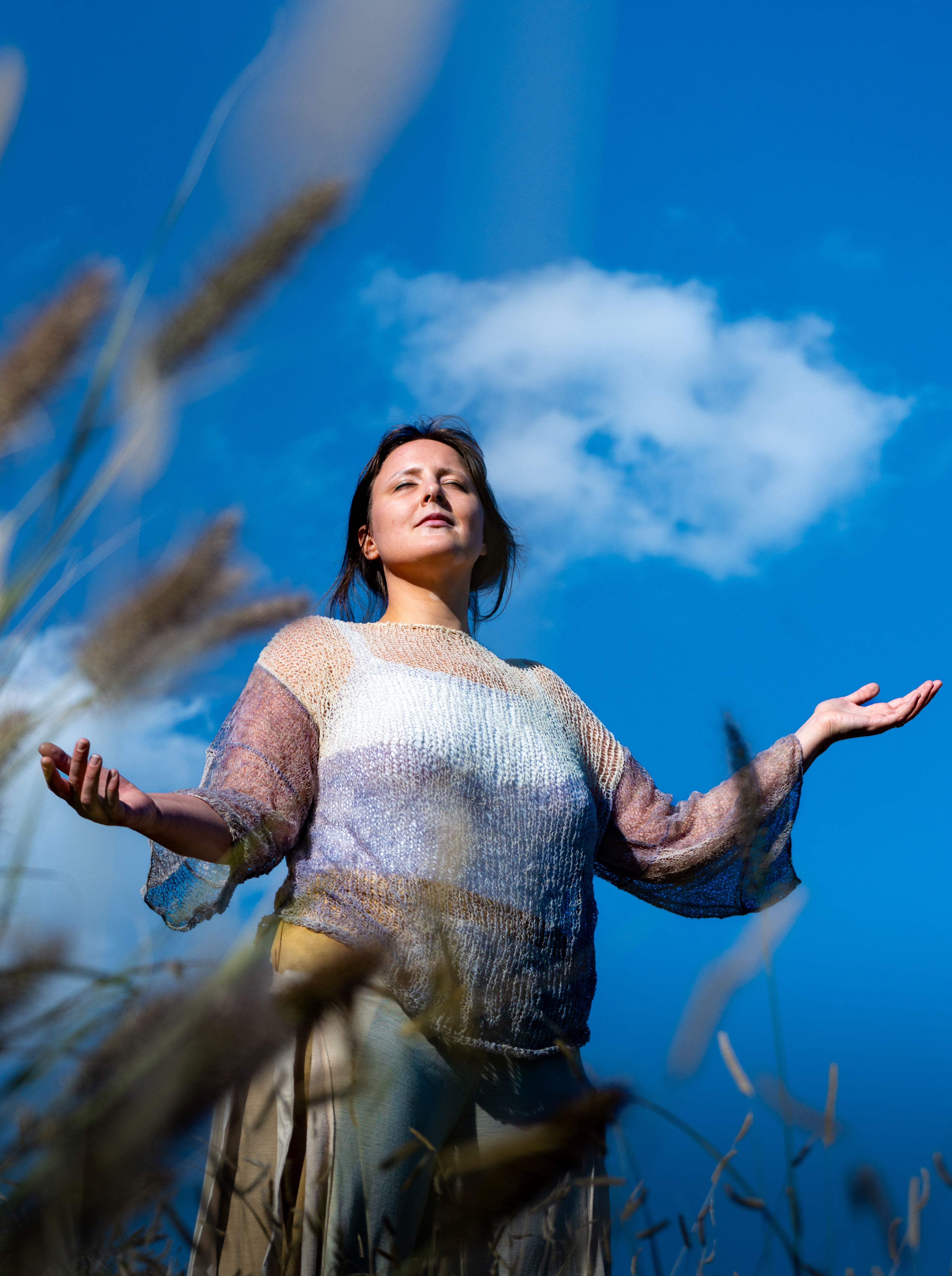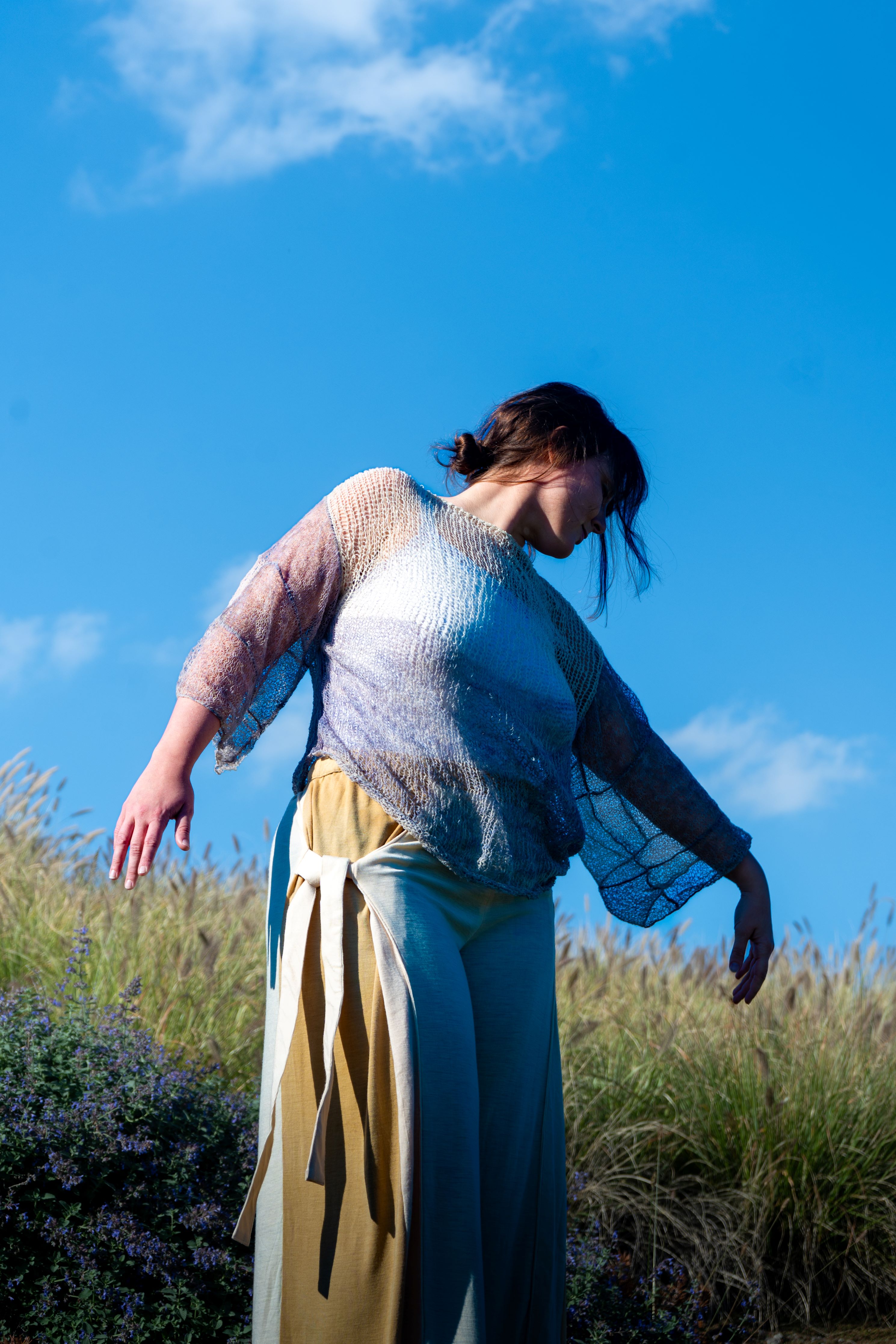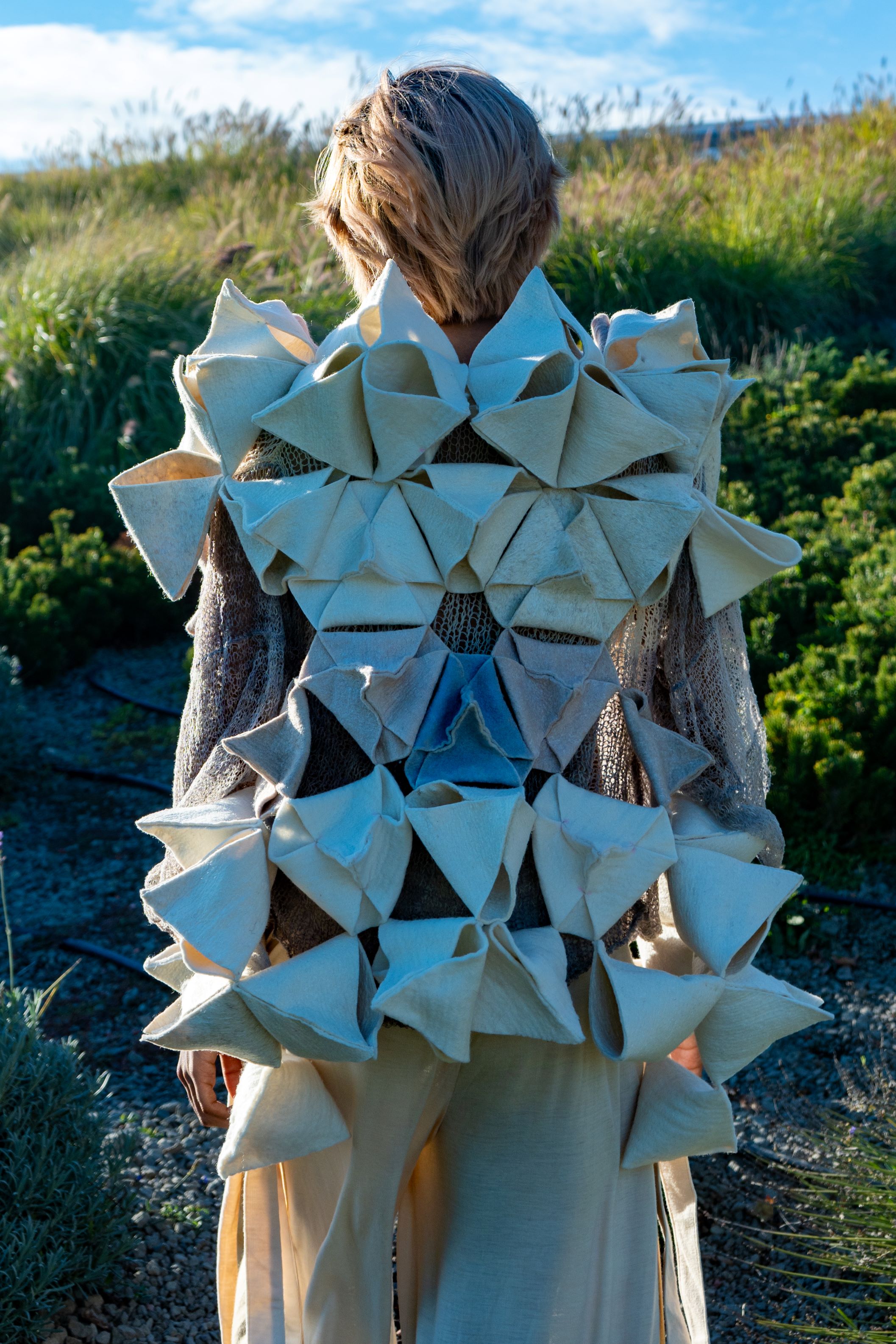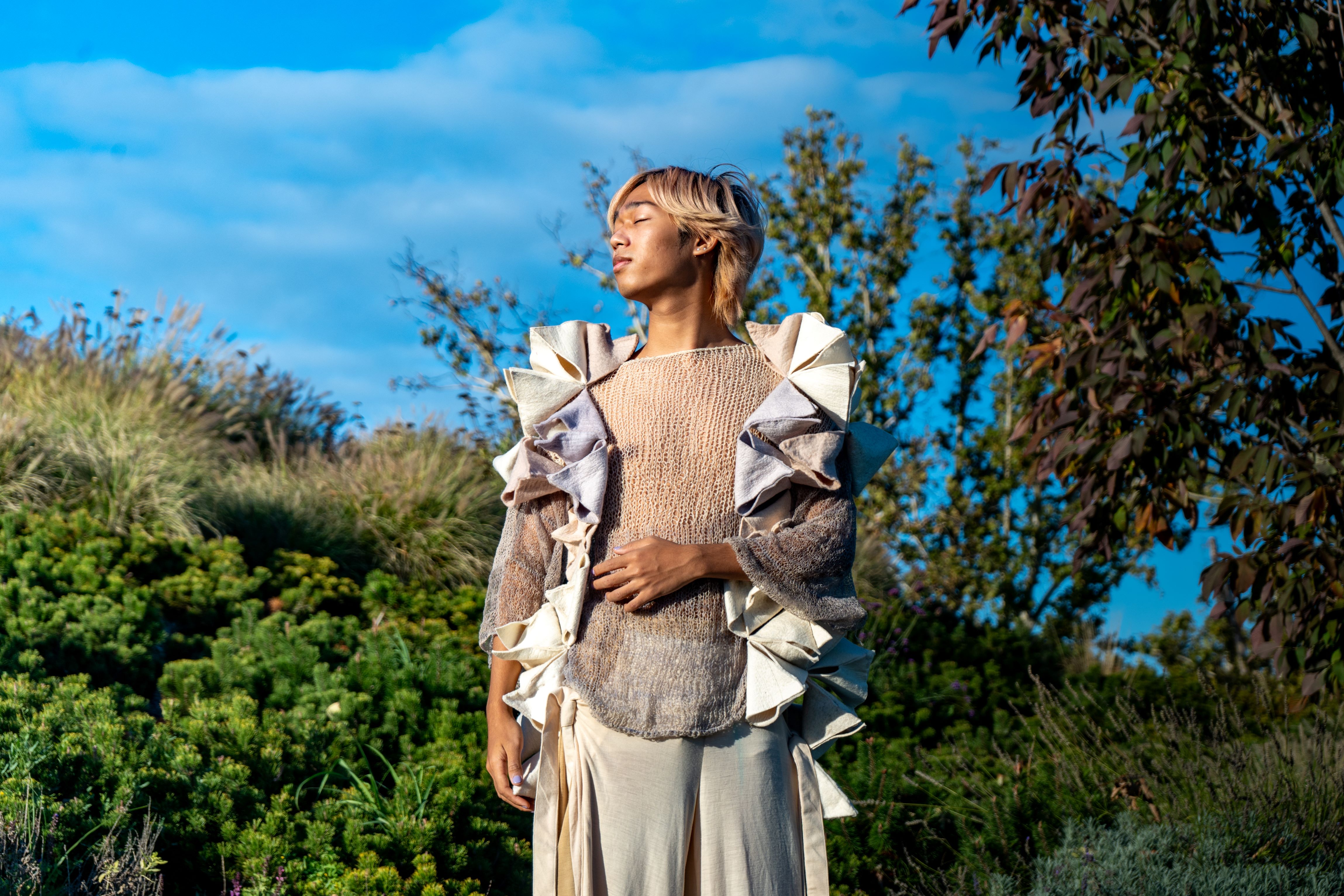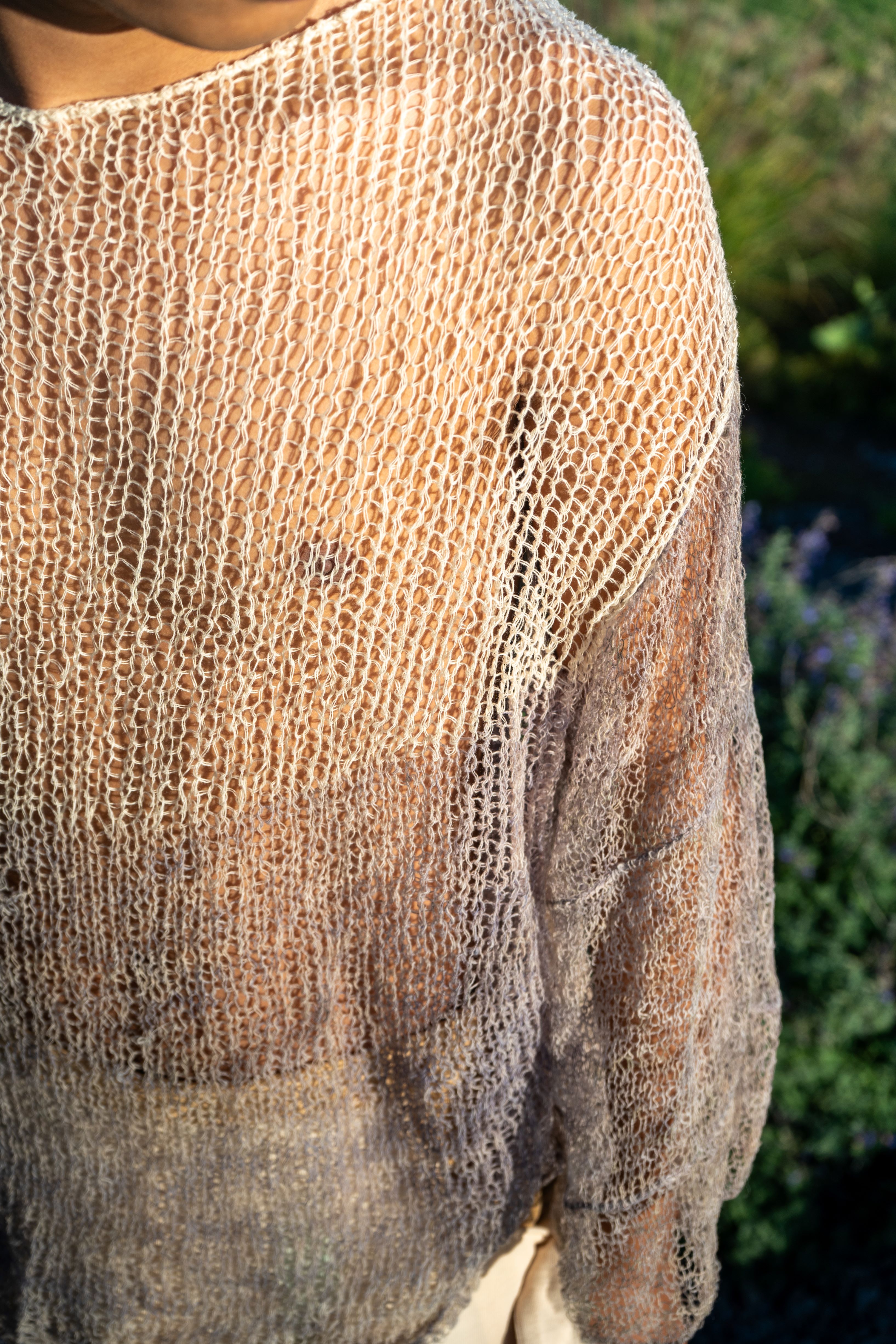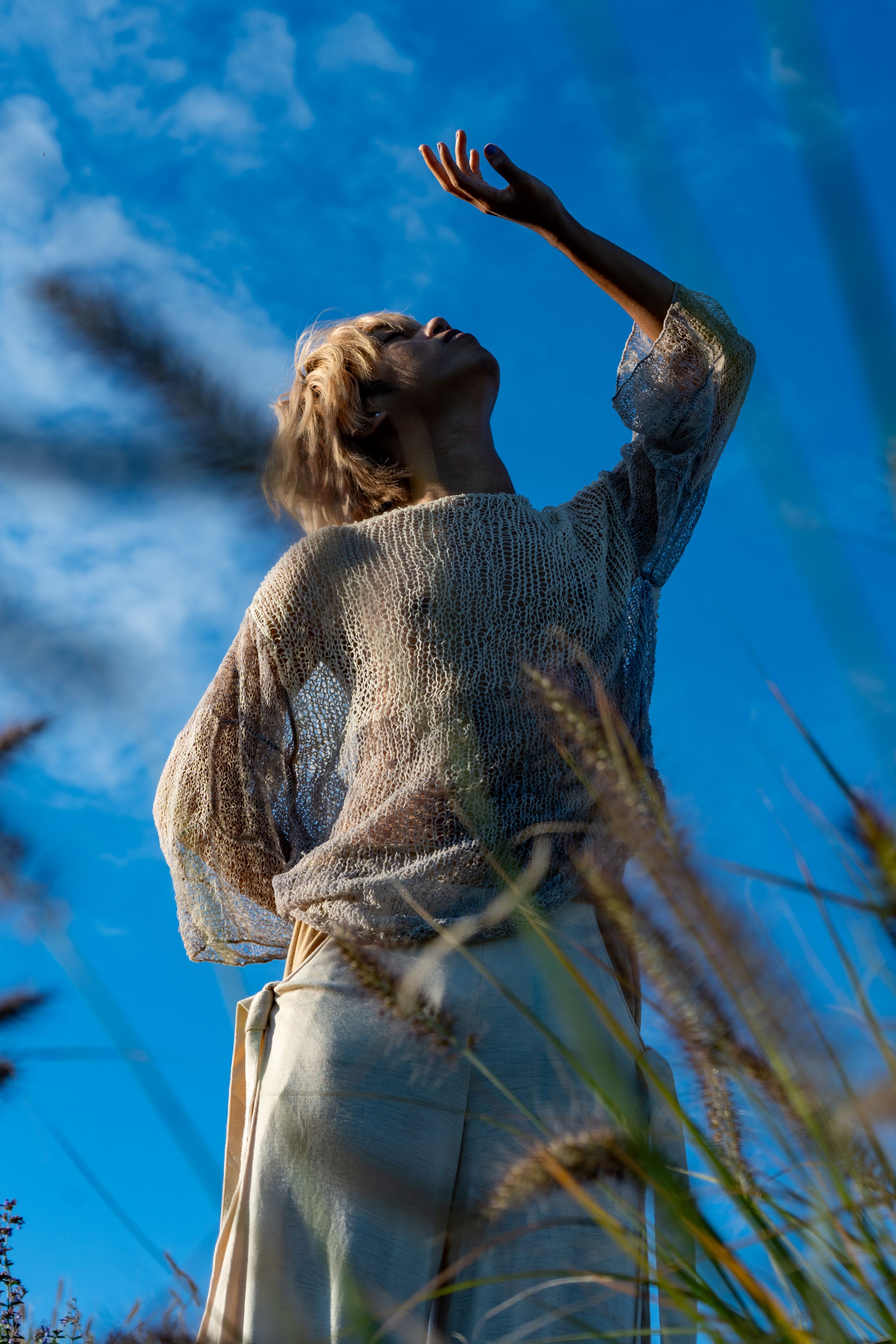Shaping a circular industrial ecosystem and supporting life-cycle thinking
Biowoolness
Can Sheep and Bacteria be Friends?
Revolutionizing fashion with nature’s colors—our project blends sustainable wool with eco-friendly microbial pigments to create beautiful, biodegradable textiles. By combining cutting-edge technology and traditional craftsmanship, we’re paving the way for a more ethical, long-lasting future in fashion. Join us in making a bold, colorful statement for the planet!
Austria
Regional
Austria and Hungary
It addresses urban-rural linkages
It refers to other types of transformations (soft investment)
Yes
2024-04-21
Yes
WORTH Partnership Project II, 2024
New European Bauhaus Catalyse Program 2024
No
No
As a representative of an organisation, in partnership with other organisations
Project Summary
Our project pioneers sustainable microbial dyeing for wool, merging biotechnology with fashion design to create biodegradable, non-toxic textiles. By replacing synthetic dyes with microbial pigments, we introduce a low-impact alternative that preserves wool’s natural properties while reducing environmental harm.
Overall Aim
To revolutionize wool dyeing by integrating microbial pigments, promoting local wool sourcing, and demonstrating a sustainable, creative alternative to synthetic dyes.
Target Groups
- Fashion designers & brands seeking sustainable dyeing methods.
- Wool farmers & SMEs exploring eco-friendly processing alternatives.
- Consumers & creative communities advocating for body-positive, gender-neutral fashion.
- Textile researchers & industry experts advancing biobased innovations.
Specific Objectives
- Develop and test microbial dyeing on various wool qualities.
- Integrate color psychology and gender-neutral aesthetics into design.
- Strengthen local supply chains by collaborating with wool farmers and textile SMEs.
- Bridge deep tech and sustainable fashion through cross-sector partnerships.
- Educate stakeholders through workshops on microbial dyeing, body positivity, and gender in fashion.
Achieved Outcomes
- Successfully dyed wool textiles with microbial pigments, ensuring biodegradability.
- Created a collection incorporating local wool and innovative dyeing techniques.
- Strengthened European collaboration between science, design, and sustainability sectors.
- Developed a workshop concept to educate designers, consumers, and industry players.
- Showcased the potential of microbial pigments for broader textile applications.
By blending deep tech with fashion, we offer a scalable, sustainable alternative for the global textile industry, demonstrating that biobased innovations can drive the future of fashion.
Our project pioneers sustainable microbial dyeing for wool, merging biotechnology with fashion design to create biodegradable, non-toxic textiles. By replacing synthetic dyes with microbial pigments, we introduce a low-impact alternative that preserves wool’s natural properties while reducing environmental harm.
Overall Aim
To revolutionize wool dyeing by integrating microbial pigments, promoting local wool sourcing, and demonstrating a sustainable, creative alternative to synthetic dyes.
Target Groups
- Fashion designers & brands seeking sustainable dyeing methods.
- Wool farmers & SMEs exploring eco-friendly processing alternatives.
- Consumers & creative communities advocating for body-positive, gender-neutral fashion.
- Textile researchers & industry experts advancing biobased innovations.
Specific Objectives
- Develop and test microbial dyeing on various wool qualities.
- Integrate color psychology and gender-neutral aesthetics into design.
- Strengthen local supply chains by collaborating with wool farmers and textile SMEs.
- Bridge deep tech and sustainable fashion through cross-sector partnerships.
- Educate stakeholders through workshops on microbial dyeing, body positivity, and gender in fashion.
Achieved Outcomes
- Successfully dyed wool textiles with microbial pigments, ensuring biodegradability.
- Created a collection incorporating local wool and innovative dyeing techniques.
- Strengthened European collaboration between science, design, and sustainability sectors.
- Developed a workshop concept to educate designers, consumers, and industry players.
- Showcased the potential of microbial pigments for broader textile applications.
By blending deep tech with fashion, we offer a scalable, sustainable alternative for the global textile industry, demonstrating that biobased innovations can drive the future of fashion.
circular fashion
biobased pigments
inclusive design
gender neutrality
european wool
This project highlights the fusion of two sustainable materials—wool, a fiber used by humans for millennia, and microbial pigments, a modern innovation in natural colorants. Wool’s durability and timeless appeal make it an emotionally and physically long-lasting material, seen in ancient textiles like those from Hallstatt's salt mines. As a natural, carbon-rich fiber, wool plays a role in the carbon cycle, with 50% of its weight being organic carbon. Its long lifespan, minimal washing needs, and high recyclability—6% of the total wool market—reduce environmental impact. Being biodegradable, wool decomposes naturally without contributing to microplastic pollution.
We sourced high-quality wool from Multifelt in Hungary, Südwolle in Italy, Mehler Tuchfabrik in Germany, and farmers across Hungary and Sweden. Direct engagement with suppliers included site visits and collaborations, with Multifelt actively supporting our outreach through social media. It was important to source European wool that is locally available and has come under pressure from large sheep farming operations in Australasia.
Microbial pigments, in contrast, represent a cutting-edge approach to sustainable dyeing. Produced by bacteria and fungi, these bio-based pigments are cultivated at room temperature, avoiding the high-energy processes of petrochemical dyes. Our CO₂ impact assessment, conducted with CIF Tool from Climate KIC’s New European Bauhaus Catalyse Program, showed that 1 kg of our pigment reduces CO₂ emissions by 34 tons annually—equivalent to the yearly electricity use of 14 EU households.
VTL's microorganisms are sourced from nature, in Austria and from all over Europe highlighting the biodiversity of the microcosms and the how rich is Europe with natural resources.
By combining traditional wool craftsmanship with deep-tech microbial dyeing, this project demonstrates a forward-thinking, low-impact alternative to synthetic dyeing while preserving the legacy of natural fibers.
We sourced high-quality wool from Multifelt in Hungary, Südwolle in Italy, Mehler Tuchfabrik in Germany, and farmers across Hungary and Sweden. Direct engagement with suppliers included site visits and collaborations, with Multifelt actively supporting our outreach through social media. It was important to source European wool that is locally available and has come under pressure from large sheep farming operations in Australasia.
Microbial pigments, in contrast, represent a cutting-edge approach to sustainable dyeing. Produced by bacteria and fungi, these bio-based pigments are cultivated at room temperature, avoiding the high-energy processes of petrochemical dyes. Our CO₂ impact assessment, conducted with CIF Tool from Climate KIC’s New European Bauhaus Catalyse Program, showed that 1 kg of our pigment reduces CO₂ emissions by 34 tons annually—equivalent to the yearly electricity use of 14 EU households.
VTL's microorganisms are sourced from nature, in Austria and from all over Europe highlighting the biodiversity of the microcosms and the how rich is Europe with natural resources.
By combining traditional wool craftsmanship with deep-tech microbial dyeing, this project demonstrates a forward-thinking, low-impact alternative to synthetic dyeing while preserving the legacy of natural fibers.
When discussing pigments and fibre, the experience of colour, clothing design, and the message behind the project stand out. Wool is an incredible fibre, yet it accounts for only 1% of global fibre use. Biowoolness aimed to declare: "Wool is not dead! It’s a great material—modern, aesthetic, and compatible with new technologies!"
The title "Can Sheep and Bacteria be Friends?" carries deep meaning. It highlights the struggles of small sheep farmers and wool businesses in Europe, which cannot compete with large-scale farming in the US, China, and Australia. Do we really want to abandon European sheep farming? Are our native breeds truly less valuable than Merino and others?
We also explored gender-neutral colours—do they exist? Colour choice is highly subjective, shaping how we decorate, dress, and even select food. Natural colours, unlike synthetic ones, are believed to have a calming effect and blend harmoniously.
The deliberate choice of knitted materials, fine soft wool, felt, and strong knit aimed to create a unique aesthetic. The felted jacket with pyramids symbolises the future and the power of many, representing the microorganisms used to colour the wool. The meticulously finely hand knitted top is a reference to human vulnerability, and the transparency is a playing with the idea of gender identity. The pants are playful and as all pieces one size fits all.
Based on the modular and zero waste and less waste design principles, we have created pieces that can easily use the experience and knowledge gained so far in the project to develop new pieces. The triangle shape can be adapted to a wide range of body shapes and lifestyles and volumes, without creating tailoring waste. The trousers are designed to fit different waists with a 30 cm difference - for men and women. The pullover design will look good on a range of body shapes and sizes, made with zero waste.
The title "Can Sheep and Bacteria be Friends?" carries deep meaning. It highlights the struggles of small sheep farmers and wool businesses in Europe, which cannot compete with large-scale farming in the US, China, and Australia. Do we really want to abandon European sheep farming? Are our native breeds truly less valuable than Merino and others?
We also explored gender-neutral colours—do they exist? Colour choice is highly subjective, shaping how we decorate, dress, and even select food. Natural colours, unlike synthetic ones, are believed to have a calming effect and blend harmoniously.
The deliberate choice of knitted materials, fine soft wool, felt, and strong knit aimed to create a unique aesthetic. The felted jacket with pyramids symbolises the future and the power of many, representing the microorganisms used to colour the wool. The meticulously finely hand knitted top is a reference to human vulnerability, and the transparency is a playing with the idea of gender identity. The pants are playful and as all pieces one size fits all.
Based on the modular and zero waste and less waste design principles, we have created pieces that can easily use the experience and knowledge gained so far in the project to develop new pieces. The triangle shape can be adapted to a wide range of body shapes and lifestyles and volumes, without creating tailoring waste. The trousers are designed to fit different waists with a 30 cm difference - for men and women. The pullover design will look good on a range of body shapes and sizes, made with zero waste.
Wool is a durable, recyclable fibre that prioritises longevity and cost-effectiveness over fast fashion. We wanted to people to remember wool, to engage with it differently from your knitted pullover in winter. We wanted to show that wool can be worn 365 days a year, with the aery design and layers.
Similarly, SMEs are the backbone of the European economy, representing 99% of all businesses, employing 100 million people, and contributing over 50% of the EU’s GDP, according to the European Commission. PinkPonilo is involved in communal work and bringing people together, learning about the detrimental effects of slow fashion and promoting a more sustainable use of textiles and fashion. VTL is a biotech company dedicated to improve the world of fashion for many textile workers and end consumers. Both companies are led by women.
An important aspect was incorporating gender neutrality. Stereotypical clothing and design are gaining momentum, while the world appears to be regressing in many areas. We firmly believe that the scientific foundations of gender research and the freedom for individuals to live their identity represent significant progress in human evolution. As many countries challenge these societal and scientific advancements, we wanted to make a clear statement.
PinkPonilo in Budapest operates under the constraints of Hungary’s gender policies, which do not align with the broader European vision. The garments are exhibited in Hungary, including at Budapest Design Week and the Goldberger Muzeum. We believe that the happiness and acceptance of every individual should be a fundamental aim of society. Marginalising and criminalising gender identities is an injustice.
These thinking processes were all included in the design of this project.
Similarly, SMEs are the backbone of the European economy, representing 99% of all businesses, employing 100 million people, and contributing over 50% of the EU’s GDP, according to the European Commission. PinkPonilo is involved in communal work and bringing people together, learning about the detrimental effects of slow fashion and promoting a more sustainable use of textiles and fashion. VTL is a biotech company dedicated to improve the world of fashion for many textile workers and end consumers. Both companies are led by women.
An important aspect was incorporating gender neutrality. Stereotypical clothing and design are gaining momentum, while the world appears to be regressing in many areas. We firmly believe that the scientific foundations of gender research and the freedom for individuals to live their identity represent significant progress in human evolution. As many countries challenge these societal and scientific advancements, we wanted to make a clear statement.
PinkPonilo in Budapest operates under the constraints of Hungary’s gender policies, which do not align with the broader European vision. The garments are exhibited in Hungary, including at Budapest Design Week and the Goldberger Muzeum. We believe that the happiness and acceptance of every individual should be a fundamental aim of society. Marginalising and criminalising gender identities is an injustice.
These thinking processes were all included in the design of this project.
Through exhibitions, workshops, guided tours, and educational events, we reached a diverse audience, fostering awareness and interaction with biobased dyeing innovations. Our project actively involved citizens and civil society at multiple levels, ensuring that sustainability, inclusivity, and local engagement were at the core of our approach.
PinkPonilo has been a studio that involves individuals that care about clothes and want to learn about traditional and modern ways of design and recycling. PinkPonilo has provided many workshops, lectures and engagements in Hungary and beyond.
Our project actively involved citizens through exhibitions, workshops, and educational events, fostering awareness and interaction with biobased dyeing innovations.
Milan Design Week: International audience, number of participants unknown.
Vienna Design Week: 2-day workshop with 20 local designers and professionals
Budapest Design Week (Goldberger Museum):
Opening event (Sept 3, 2024) – 100 participants (local professionals, weavers, museum experts)
Closing event (Nov 2024) – 70 participants.
Guided tour & presentation – 20 participants (students, color and fashion enthusiasts).
Budapest Central European Fashion Week: Open studio day with 10 Hungarian participants.
Education & Knowledge Sharing
Budapest Metropolitan University: 20 fashion management students analyzed the project.
Online presentation to Fibershed DACH: Reached a wider sustainable textile
Vienna Textile Lab has focused on enabling young women in STEM related education, providing internships and jobs for young female professionals. VTL has employed women from all over Europe and beyond, supporting students in their bachelor, masters and PhDs, allowing a better life and income for women (over 20 women have benefited from VTL).
PinkPonilo has been a studio that involves individuals that care about clothes and want to learn about traditional and modern ways of design and recycling. PinkPonilo has provided many workshops, lectures and engagements in Hungary and beyond.
Our project actively involved citizens through exhibitions, workshops, and educational events, fostering awareness and interaction with biobased dyeing innovations.
Milan Design Week: International audience, number of participants unknown.
Vienna Design Week: 2-day workshop with 20 local designers and professionals
Budapest Design Week (Goldberger Museum):
Opening event (Sept 3, 2024) – 100 participants (local professionals, weavers, museum experts)
Closing event (Nov 2024) – 70 participants.
Guided tour & presentation – 20 participants (students, color and fashion enthusiasts).
Budapest Central European Fashion Week: Open studio day with 10 Hungarian participants.
Education & Knowledge Sharing
Budapest Metropolitan University: 20 fashion management students analyzed the project.
Online presentation to Fibershed DACH: Reached a wider sustainable textile
Vienna Textile Lab has focused on enabling young women in STEM related education, providing internships and jobs for young female professionals. VTL has employed women from all over Europe and beyond, supporting students in their bachelor, masters and PhDs, allowing a better life and income for women (over 20 women have benefited from VTL).
Stakeholder Engagement at Multiple Levels
Our project brought together diverse stakeholders—local, regional, national, and European—ensuring scientific innovation, sustainable design, and industry relevance.
Local Level: Wool Farmers, SMEs, and Designers
We collaborated with local wool farmers and textile SMEs to explore sustainable wool processing. Pink Ponilo contributed design expertise, researching color psychology and gender-neutral aesthetics. This strengthened local supply chains, preserved traditional craftsmanship, and integrated modern dyeing techniques.
Regional Level: Research Institutions and Industry Experts
Microbiologists, bioengineers, and textile experts optimized microbial dyeing for different fabrics. Their input ensured scientific rigor, scalable techniques, and industry relevance, bridging deep tech and fashion.
National Level: Innovation Hubs and Sustainability Networks
VTL has been supported by national funding agencies, mentorship, and networking opportunities. This support accelerated project development, increased visibility, and fostered cross-sector collaboration.
European Level: Research Programs and Policy Initiatives
EU-funded WORTH Partnership Project provided a unique opportunity to create Biowoolness, while Vienna Textile Lab participated in the New European Bauhaus Catalyse Program.
Impact
By engaging stakeholders at all levels, we combined science, creativity, and sustainability, ensuring practical applications, strong community backing, and scalable industry adoption. With the support of NEB Catalyse we could deep dive into the sustainability assessment and could engage with experts/
Our project brought together diverse stakeholders—local, regional, national, and European—ensuring scientific innovation, sustainable design, and industry relevance.
Local Level: Wool Farmers, SMEs, and Designers
We collaborated with local wool farmers and textile SMEs to explore sustainable wool processing. Pink Ponilo contributed design expertise, researching color psychology and gender-neutral aesthetics. This strengthened local supply chains, preserved traditional craftsmanship, and integrated modern dyeing techniques.
Regional Level: Research Institutions and Industry Experts
Microbiologists, bioengineers, and textile experts optimized microbial dyeing for different fabrics. Their input ensured scientific rigor, scalable techniques, and industry relevance, bridging deep tech and fashion.
National Level: Innovation Hubs and Sustainability Networks
VTL has been supported by national funding agencies, mentorship, and networking opportunities. This support accelerated project development, increased visibility, and fostered cross-sector collaboration.
European Level: Research Programs and Policy Initiatives
EU-funded WORTH Partnership Project provided a unique opportunity to create Biowoolness, while Vienna Textile Lab participated in the New European Bauhaus Catalyse Program.
Impact
By engaging stakeholders at all levels, we combined science, creativity, and sustainability, ensuring practical applications, strong community backing, and scalable industry adoption. With the support of NEB Catalyse we could deep dive into the sustainability assessment and could engage with experts/
Vienna Textile Lab and PinkPonilo are two distinct yet complementary entities, each bringing unique expertise to the collaboration.
Vienna Textile Lab is a deep-tech startup driven by microbiologists, bioengineers, chemists, and textile engineers. We focus on pioneering biotechnological solutions for sustainable dyeing, merging scientific innovation with industrial application.
PinkPonilo, on the other hand, is a creative design studio dedicated to sustainable and ethical fashion. It serves as a hub for designers, makers, and engaged citizens who seek to challenge fast fashion, create their own designs, and explore both traditional and emerging textile techniques.
As scientists, Vienna Textile Lab is committed to biobased materials, pioneering sustainable alternatives through cutting-edge research. PinkPonilo, with its creative expertise and engaged community, brings the vision to life—serving as a bridge between innovation and cultural transformation. Their network of designers, makers, and conscious consumers represents the early adopters of the new fashion revolution, embracing sustainability not just as a trend but as a movement toward lasting change. Together, we bridge the gap between science and design, pushing the boundaries of fashion innovation while fostering a deeper understanding of responsible textile production.
The interaction between these fields was highly dynamic. Scientists worked closely with designers to translate lab-based innovations into practical textile applications. Designers and artisans provided feedback on color behavior, material properties, and consumer preferences, which informed adjustments in the microbial dyeing process. The collaboration with wool producers ensured that the sourced material aligned with project goals.
The added value of this approach was the creation of a truly holistic process—combining science, craftsmanship, and sustainability.
Vienna Textile Lab is a deep-tech startup driven by microbiologists, bioengineers, chemists, and textile engineers. We focus on pioneering biotechnological solutions for sustainable dyeing, merging scientific innovation with industrial application.
PinkPonilo, on the other hand, is a creative design studio dedicated to sustainable and ethical fashion. It serves as a hub for designers, makers, and engaged citizens who seek to challenge fast fashion, create their own designs, and explore both traditional and emerging textile techniques.
As scientists, Vienna Textile Lab is committed to biobased materials, pioneering sustainable alternatives through cutting-edge research. PinkPonilo, with its creative expertise and engaged community, brings the vision to life—serving as a bridge between innovation and cultural transformation. Their network of designers, makers, and conscious consumers represents the early adopters of the new fashion revolution, embracing sustainability not just as a trend but as a movement toward lasting change. Together, we bridge the gap between science and design, pushing the boundaries of fashion innovation while fostering a deeper understanding of responsible textile production.
The interaction between these fields was highly dynamic. Scientists worked closely with designers to translate lab-based innovations into practical textile applications. Designers and artisans provided feedback on color behavior, material properties, and consumer preferences, which informed adjustments in the microbial dyeing process. The collaboration with wool producers ensured that the sourced material aligned with project goals.
The added value of this approach was the creation of a truly holistic process—combining science, craftsmanship, and sustainability.
We are revolutionizing wool dyeing by merging tradition with cutting-edge biotechnology. Our modern, body-positive, and gender-neutral designs go beyond aesthetics—they embody a radical shift in sustainable textile innovation.
Mainstream wool dyeing relies on heavy synthetic dyes and wool sourced predominantly from China, Australia, and New Zealand. While wool remains a staple in luxury fashion, knitwear, accessories, and high-performance sportswear, European wool production is significantly smaller than in Oceania and Asia, despite being the world’s second-largest market.
By introducing microbial pigments and advanced dyeing technologies, we propel wool design into the next century. Unlike conventionally dyed wool, our all-natural process ensures good biodegradability—eliminating synthetic dye pollution while preserving the integrity of this premium material.
Incorporating novel societal advances like gender and color research, paired with body positivity is a commitment of both companies that we are looking forward and embracing change and each and every individual.
Mainstream wool dyeing relies on heavy synthetic dyes and wool sourced predominantly from China, Australia, and New Zealand. While wool remains a staple in luxury fashion, knitwear, accessories, and high-performance sportswear, European wool production is significantly smaller than in Oceania and Asia, despite being the world’s second-largest market.
By introducing microbial pigments and advanced dyeing technologies, we propel wool design into the next century. Unlike conventionally dyed wool, our all-natural process ensures good biodegradability—eliminating synthetic dye pollution while preserving the integrity of this premium material.
Incorporating novel societal advances like gender and color research, paired with body positivity is a commitment of both companies that we are looking forward and embracing change and each and every individual.
We pushed beyond conventional knowledge of wool by conducting in-depth research, engaging with local wool farmers, SMEs specializing in wool treatment, and large industry players. Through this process, we sourced a variety of wool qualities and natural shades, which not only enriched our understanding but also opened new possibilities for color design by integrating the wool’s inherent hues.
Next, we experimented with yarns, felt, and knitted textiles, testing different microbial colors and their interactions with the material. Our approach was multifaceted: we dyed with pigments, allowed microorganisms to grow directly on the wool, and explored textile printing techniques.
Meanwhile, PinkPonilo delved into the cultural and psychological aspects of color, investigating preferences and the concept of a gender-neutral palette. Together, we carefully curated the final color compositions for our designs.
In Vienna, we dyed yarns, felt, and knitted textiles before sending them to Budapest, where the PinkPonilo team transformed them into stunning final pieces. They carefully hand knitted the pullovers, crafted the felt pyramids, and assembled the jacket from these elements. The trousers were tailored in a traditional cut, bridging heritage with modern design.
Beyond creating garments, this collaboration evolved into an educational initiative. Vienna Textile Lab and PinkPonilo are now developing a workshop concept that explores local wool, color theory, body positivity, gender in fashion, and microbial dyeing—empowering participants with knowledge and creativity.
Next, we experimented with yarns, felt, and knitted textiles, testing different microbial colors and their interactions with the material. Our approach was multifaceted: we dyed with pigments, allowed microorganisms to grow directly on the wool, and explored textile printing techniques.
Meanwhile, PinkPonilo delved into the cultural and psychological aspects of color, investigating preferences and the concept of a gender-neutral palette. Together, we carefully curated the final color compositions for our designs.
In Vienna, we dyed yarns, felt, and knitted textiles before sending them to Budapest, where the PinkPonilo team transformed them into stunning final pieces. They carefully hand knitted the pullovers, crafted the felt pyramids, and assembled the jacket from these elements. The trousers were tailored in a traditional cut, bridging heritage with modern design.
Beyond creating garments, this collaboration evolved into an educational initiative. Vienna Textile Lab and PinkPonilo are now developing a workshop concept that explores local wool, color theory, body positivity, gender in fashion, and microbial dyeing—empowering participants with knowledge and creativity.
Our project combines deep-tech innovation with creative fashion design, making several aspects highly adaptable across different contexts, industries, and beneficiary groups.
1. Technology and Processes
Microbial Dyeing Methods: The microbial pigment dyeing process can be applied to various natural fibers beyond wool, such as cotton, linen, and silk, allowing different textile industries to adopt more sustainable coloration techniques.
Dye Application Techniques: The tested methods—pigment dyeing, direct microbial growth on fibers, and printing—can be replicated in different textile sectors, from luxury fashion to performance wear.
Scalability Potential: As microbial dye production becomes more optimized, it can be integrated into existing textile dyeing facilities worldwide, replacing synthetic dyes in both artisanal and industrial settings.
2. Knowledge Transfer and Community Engagement
Educational Workshops: The workshop concept developed with PinkPonilo can be replicated in different locations to educate designers, consumers, and students on sustainable textiles, microbial dyes, gender-neutral fashion, and body positivity.
Early Adopter Communities: The engagement model of working with creatives, designers, and conscious consumers can be expanded to other regions, helping to drive demand for bio-based materials and ethical fashion practices.
3. Application in Different Contexts
Fashion and Textiles: Brands and designers worldwide can incorporate microbial dyes into their collections, adapting them to local wool and other natural fiber sources.
Circular Economy Initiatives: The project serves as a model for integrating local raw materials, sustainable dyeing, and biodegradable textiles into circular fashion systems.
Scientific Research and Innovation: The methodologies developed for microbial dye application can inspire further research in bio-based colorants for other industries, such as cosmetic, food packaging, and interior design.
1. Technology and Processes
Microbial Dyeing Methods: The microbial pigment dyeing process can be applied to various natural fibers beyond wool, such as cotton, linen, and silk, allowing different textile industries to adopt more sustainable coloration techniques.
Dye Application Techniques: The tested methods—pigment dyeing, direct microbial growth on fibers, and printing—can be replicated in different textile sectors, from luxury fashion to performance wear.
Scalability Potential: As microbial dye production becomes more optimized, it can be integrated into existing textile dyeing facilities worldwide, replacing synthetic dyes in both artisanal and industrial settings.
2. Knowledge Transfer and Community Engagement
Educational Workshops: The workshop concept developed with PinkPonilo can be replicated in different locations to educate designers, consumers, and students on sustainable textiles, microbial dyes, gender-neutral fashion, and body positivity.
Early Adopter Communities: The engagement model of working with creatives, designers, and conscious consumers can be expanded to other regions, helping to drive demand for bio-based materials and ethical fashion practices.
3. Application in Different Contexts
Fashion and Textiles: Brands and designers worldwide can incorporate microbial dyes into their collections, adapting them to local wool and other natural fiber sources.
Circular Economy Initiatives: The project serves as a model for integrating local raw materials, sustainable dyeing, and biodegradable textiles into circular fashion systems.
Scientific Research and Innovation: The methodologies developed for microbial dye application can inspire further research in bio-based colorants for other industries, such as cosmetic, food packaging, and interior design.
Our project tackles some of the most pressing global challenges in the textile and fashion industry by developing locally sourced, bio-based dyeing solutions that can be scaled internationally.
1. Environmental Pollution from Synthetic Dyes → Solution: Microbial Pigments
Global Challenge: The synthetic dyeing industry is a major contributor to water pollution, toxic waste, and high energy consumption. Conventional dyes release hazardous chemicals into ecosystems, particularly in regions with lax environmental regulations.
Local Solution: Our project pioneers microbial pigments as a sustainable alternative to synthetic dyes. By leveraging locally cultivated microorganisms and wool, we reduce chemical pollution, lower water usage, and create biodegradable textiles.
2. Fast Fashion and Resource Exploitation → Solution: Local Wool and Ethical Production
Global Challenge: The global textile industry is dominated by mass production, leading to overconsumption, resource depletion, and exploitative labor practices. Wool is often sourced from large-scale farms in Australia, New Zealand, and China, increasing carbon footprints through transportation and intensive farming.
Local Solution: We work with regional wool farmers, supporting sustainable, ethical wool production while reducing transportation emissions. By promoting local materials and artisanal craftsmanship, we contribute to a more responsible, transparent supply chain.
3. Loss of Traditional Craftsmanship → Solution: Merging Traditional and New Techniques
Global Challenge:Traditional textile techniques are disappearing as fast fashion prioritizes speed and low costs over craftsmanship. This leads to a loss of cultural heritage and skills.
Local Solution: By researching and implementing a gender-neutral color palette and body-positive fashion choices, our project challenges outdated norms and promotes inclusivity in design.
1. Environmental Pollution from Synthetic Dyes → Solution: Microbial Pigments
Global Challenge: The synthetic dyeing industry is a major contributor to water pollution, toxic waste, and high energy consumption. Conventional dyes release hazardous chemicals into ecosystems, particularly in regions with lax environmental regulations.
Local Solution: Our project pioneers microbial pigments as a sustainable alternative to synthetic dyes. By leveraging locally cultivated microorganisms and wool, we reduce chemical pollution, lower water usage, and create biodegradable textiles.
2. Fast Fashion and Resource Exploitation → Solution: Local Wool and Ethical Production
Global Challenge: The global textile industry is dominated by mass production, leading to overconsumption, resource depletion, and exploitative labor practices. Wool is often sourced from large-scale farms in Australia, New Zealand, and China, increasing carbon footprints through transportation and intensive farming.
Local Solution: We work with regional wool farmers, supporting sustainable, ethical wool production while reducing transportation emissions. By promoting local materials and artisanal craftsmanship, we contribute to a more responsible, transparent supply chain.
3. Loss of Traditional Craftsmanship → Solution: Merging Traditional and New Techniques
Global Challenge:Traditional textile techniques are disappearing as fast fashion prioritizes speed and low costs over craftsmanship. This leads to a loss of cultural heritage and skills.
Local Solution: By researching and implementing a gender-neutral color palette and body-positive fashion choices, our project challenges outdated norms and promotes inclusivity in design.
Results, Outcomes, and Impacts of Our Project
Our project successfully merged cutting-edge biotechnology with sustainable fashion design, demonstrating the viability of microbial pigments as an eco-friendly alternative to synthetic dyes. Key achievements include:
Scientific and Technological Outcomes:
Innovative Dyeing Techniques: We developed and tested multiple microbial dyeing methods, including pigment dyeing, direct microbial growth on wool, and textile printing.
Material Exploration: We sourced and analyzed various types of local wool, integrating its natural hues into the design process for a broader color spectrum.
Scalability and Application: Our research advanced the practical use of microbial pigments in different textile forms, from yarns to knitted fabrics and felt.
Creative and Social Impact:
Sustainable Fashion Integration: Through collaboration with Pink Ponilo, we applied these innovations in real-world design, crafting unique, biodegradable garments that challenge conventional dyeing methods.
Early Adopters and Awareness: The project engaged designers, makers, and sustainability-conscious consumers, fostering a growing community of early adopters of bio-based textile solutions.
Environmental and Societal Benefits:
Reduction of Synthetic Dye Use: By promoting microbial pigments, we contribute to reducing the environmental impact of synthetic dye production and wastewater pollution.
Empowering Local Wool Industry: Our project highlights the potential of European wool, supporting regional farmers and sustainable textile practices.
Educational Outreach: We are developing a workshop concept with Pink Ponilo to educate a broader audience on local wool, microbial dyes, gender in fashion, and body positivity—expanding the long-term impact of our research.
World Sony Photo Award
Qatar Winner — © Ridhwan Mohammed Rafi
The Photo of Biowoolness was awarded the Sony World Photography Awards 2025
Our project successfully merged cutting-edge biotechnology with sustainable fashion design, demonstrating the viability of microbial pigments as an eco-friendly alternative to synthetic dyes. Key achievements include:
Scientific and Technological Outcomes:
Innovative Dyeing Techniques: We developed and tested multiple microbial dyeing methods, including pigment dyeing, direct microbial growth on wool, and textile printing.
Material Exploration: We sourced and analyzed various types of local wool, integrating its natural hues into the design process for a broader color spectrum.
Scalability and Application: Our research advanced the practical use of microbial pigments in different textile forms, from yarns to knitted fabrics and felt.
Creative and Social Impact:
Sustainable Fashion Integration: Through collaboration with Pink Ponilo, we applied these innovations in real-world design, crafting unique, biodegradable garments that challenge conventional dyeing methods.
Early Adopters and Awareness: The project engaged designers, makers, and sustainability-conscious consumers, fostering a growing community of early adopters of bio-based textile solutions.
Environmental and Societal Benefits:
Reduction of Synthetic Dye Use: By promoting microbial pigments, we contribute to reducing the environmental impact of synthetic dye production and wastewater pollution.
Empowering Local Wool Industry: Our project highlights the potential of European wool, supporting regional farmers and sustainable textile practices.
Educational Outreach: We are developing a workshop concept with Pink Ponilo to educate a broader audience on local wool, microbial dyes, gender in fashion, and body positivity—expanding the long-term impact of our research.
World Sony Photo Award
Qatar Winner — © Ridhwan Mohammed Rafi
The Photo of Biowoolness was awarded the Sony World Photography Awards 2025

